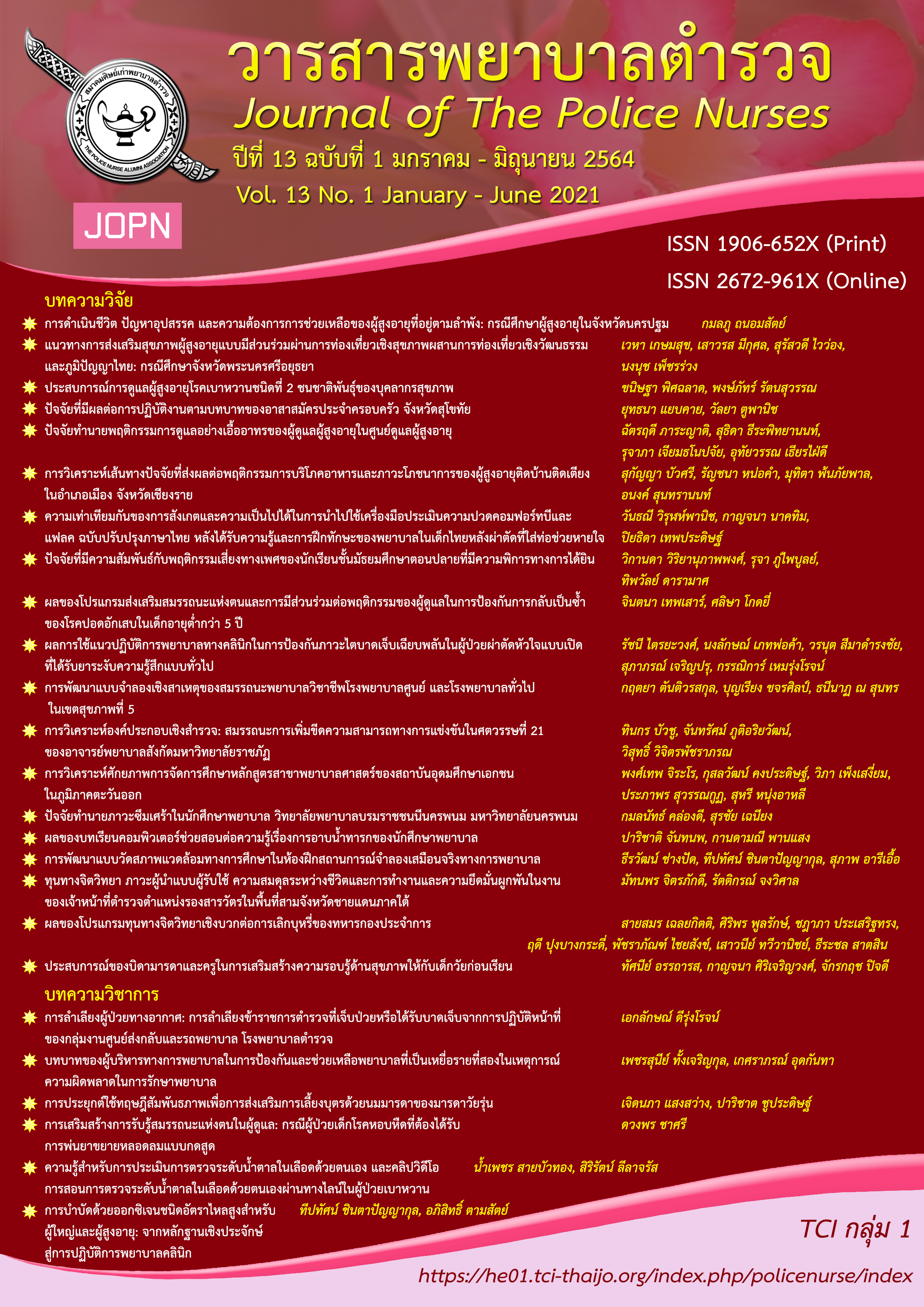EFFECTS OF CLINICAL NURSING PRACTICE GUIDELINE TO PREVENT CARDIAC SURGERY – ASSOCIATED ACUTE KIDNEY INJURY IN PATIENTS UNDERGOING OPEN HEART SURGERY
Keywords:
clinical nursing practice guideline, cardiac surgery– associated acute kidney injury, open heart surgery patientsAbstract
This research was quasi-experimental with a historical control group posttest. The objectives were to evaluate the effects of the clinical nursing practice guideline (CNPG) during surgery to prevent CS-AKI in patients undergoing open-heart surgery. The total participants were 20 anesthetist nurses and 68 patients who were undergoing open-heart surgery. The control group (n = 34), who were simple random sampled and retrospective data collected, received standard nursing care. Meanwhile, the experimental group (n = 34, purposive sampling) received nursing care followed by CNPG that was prospectively implemented and data collected. The instruments in this research consisted of 1) the CNPG during surgery to prevent CS-AKI in patients undergoing open-heart surgery and 2) the record form of adherence related to the CNPG procedure and satisfaction in using the CNPG. The content validity index was .88-1.00 and the reliabilities of each record form were 1.00, .88, and .83, respectively. Data analysis was performed using descriptive statistics and binary logistic regression.
The results of this study revealed that: 1) The proportion of CS-AKI between two groups had a statistically significant difference. The experimental group had a statistically significant chance of developing CS-AKI .27 times that of the control group. (Adjusted OR = .27, 95%CI = .08 - .92, p < .05). 2). The overall satisfaction score of volunteer nurses to CNPG was 97% and more than 92.50% adherence to the CNPG.
Downloads
References
Ahmed, G., Mohammed, Z., & Ghanem, H. (2015). “Coronary artery bypass grafting” effect of developing and implementing nursing care standards on patient’s outcomes. Journal of American Science, 11, 181-8.
Bernard, R. (2000). Fundamentals of biostatistics (5th ed.). Duxbery: Thomson learning.
Chahal, R. S., Chukwu, A. C., Kalra, P. R., & Kalra, P. K. (2020). Heart failure and acute renal dysfunction in the cardiorenal syndrome. Clinical Medicine, 20(2), 146–50.
Elmistekawy, E., McDonald, B., Hudson, C., Ruel, M., Mesana, T., Chan, V., & Boodhwani, M. (2014). Clinical impact of mild acute kidney injury after cardiac surgery. The Annals of Thoracic Surgery, 98(3), 815-22.
Englberger, L., Suri, R. M., Li, Z., Casey, E. T., Daly, R. C., Dearani, J. A., & Schaff, H. V. (2011). Clinical accuracy of RIFLE and acute kidney injury network (AKIN) criteria for acute kidney injury in patients undergoing cardiac surgery. Critical care (London, England), 15, R16.
Harky, A., Joshi, M., Gupta, S., Teoh, W. Y., Gatta, F., & Snosi, M. (2020). Acute kidney injury associated with cardiac surgery: A comprehensive literature review. Brazilian journal of cardiovascular surgery, 35(2), 211-224.
Hobson, C. E., Yavas, S., Segal, M. S., Schold, J. D.,Tribble, C. G., Layon, A. J., & Bihorac, A. (2009). Acute kidney injury is associated with increased long - term mortality after cardiothoracic surgery. Circulation, 119(18), 2444-2453.
Joslin, J., Wilson, H., Zubli, D., Gauge, N., Kinirons, M., Hopper, A., Pile, T., & Ostermann, M. (2015). Recognition and management of acute kidney injury in hospitalised patients can be partially improved with the use of a care bundle. Clinical Medicine, 15(5), 431-436.
Kellum, J. A., Lameire, N., Aspelin, P., Barsoum, R. S., Burdmann, E. A., Goldstein, S. L., . . . Uchino, S. (2012). Kidney disease: improving global outcomes (KDIGO) acute kidney injury work group. KDIGO clinical practice guideline for acute kidney injury. Kidney international supplements, 2(1), 1-138.
Krzych, Ł., Wybraniec, M., Chudek, J., & Bochenek, A. (2013). Perioperative management of cardiac surgery patients who are at the risk of acute kidney injury. Anaesthesiology Intensive Therapy, 45(3), 155-163.
Maharat Nakhon Ratchasima Hospital. (2019). Statistical records of complications after surgery. Maharat Nakhon Ratchasima Hospital.
Meersch, M., Schmidt, C., Hoffmeier, A., Van Aken, H., Wempe, C., Gerss, J., & Zarbock, A. (2017). Prevention of cardiac surgery-associated AKI by implementing the KDIGO guidelines in high risk patients identified by biomarkers: the PrevAKI randomized controlled trial. Intensive care medicine, 43(11), 1551-1561.
Mebazaa, A., Pitsis, A. A., Rudiger, A., Toller, W., Longrois, D., Ricksten, S. E., . . . Follath, F. (2010). Clinical review: practical recommendations on the management of perioperative heart failure in cardiac surgery. Critical care, 14(2), 1-14.
Ngamjarus, C., Chongsuvivatwong, V., & McNeil, E. B. (2014). n4Studies: Sample size and power calculations for android. The Thailand Research Fund: Prince of Songkla University.
Ngu, J. C., Jabagi, H., Chung, A. M., Boodhwani, M. M., Ruel, M., Bourke, M., & Sun, L. Y. (2020). Defining an intraoperative hypotension threshold in association with De Novo renal replacement therapy after cardiac surgery. Anesthesiology, 132, 1447–57.
Ramos, K. A., & Dias, C. B. (2018). Acute Kidney Injury after Cardiac Surgery. Brazilian Journal of Cardiovascular Surgery, 33(5), 454-61.
Rangaswami, J., Bhalla, V., Blair, J. E., Chang, T. I., Costa, S., Lentine, K. L., . . . American Heart Association Council on the Kidney in Cardiovascular Disease and Council on Clinical Cardiology. (2019). Cardiorenal syndrome: Classification, pathophysiology, diagnosis, and treatment strategies: A scientific statement from the American Heart Association. Circulation, 139(16), e840-e878.
Selby, N. M., & Kolhe, N. V. (2016). Care bundles for acute kidney injury: do they work?. Nephron, 134(3), 195-199.
Soukup, S. M. (2000). The center for advanced nursing practice evidence-based practice model: Promoting the scholarship of practice. Nursing Clinics of North America, 35(2), 301-309.
The AGREE Next Steps Consortium. (2009). Appraisal of guidelines for research & evaluation II. Retrieved from http://www.agreetrust.org
Zakkar, M., Bruno, V., Guida, G., Angelini, G., Chivasso, P., Suleiman, M., Bryan, A., & Ascione, R. (2016). Postoperative acute kidney injury defined by RIFLE criteria predicts early health outcome and long-term survival in patients undergoing redo coronary artery bypass graft surgery. The Journal of Thoracic and Cardiovascular Surgery, 152(1), 235-242.
Downloads
Published
How to Cite
Issue
Section
License
ผลงานที่ได้ตีพิมพ์แล้วจะเป็นลิขสิทธิ์ของวารสารพยาบาลตำรวจ















